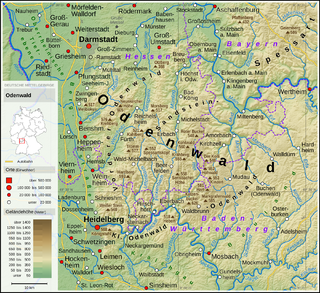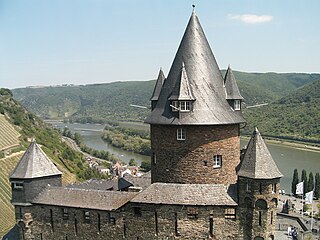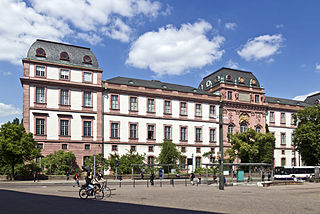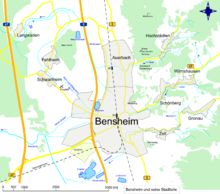
The Odenwald is a low mountain range in the German states of Hesse, Bavaria and Baden-Württemberg.

Bensheim is a town in the Bergstraße district in southern Hessen, Germany. Bensheim lies on the Bergstraße and at the edge of the Odenwald mountains while at the same time having an open view over the Rhine plain. With about 40,000 inhabitants (2016), it is the district's biggest town.

Starkenburg is an historical region in the State of Hesse, Germany, comprising the area south of the Main River and east of the Rhine, around the regional capital Darmstadt.

Heppenheim (Bergstraße) is the seat of Bergstraße district in Hesse, Germany, lying on the Bergstraße on the edge of the Odenwald. It is best known for being the birthplace of 4-time Formula One World Champion Sebastian Vettel.

Stahleck Castle is a 12th-century fortified castle in the Upper Middle Rhine Valley at Bacharach in Rhineland-Palatinate, Germany. It stands on a crag approximately 160 metres (520 ft) above sea level on the left bank of the river at the mouth of the Steeg valley, approximately 50 kilometres (31 mi) south of Koblenz, and offers a commanding view of the Lorelei valley. Its name means "impregnable castle on a crag", from the Middle High German words stahel (steel) and ecke. It has a water-filled partial moat, a rarity in Germany. Built on the orders of the Archbishop of Cologne, it was destroyed in the late 17th century but rebuilt in the 20th and is now a hostel.

Zwingenberg lies in the Bergstraße district in southern Hessen, Germany, south of Frankfurt and Darmstadt, and with the granting of town rights coming in 1274 it is the oldest town on the Hessen Bergstraße.

Sankt Goar is a town on the west bank of the Middle Rhine in the Rhein-Hunsrück-Kreis (district) in Rhineland-Palatinate, Germany. It belongs to the Verbandsgemeinde Hunsrück-Mittelrhein, whose seat is in Emmelshausen.

The Bergstraße is 80-kilometre-long (50 mi) ancient trade route in the south-west of Germany. The route and the area around it is a mountainous "theme route" running north–south along the western edge of the Odenwald forest in southern Hesse and northern Baden-Württemberg. The route passes through the Bergstraße administrative district, and independent viticultural regions of Hessische Bergstraße and Badische Bergstraße. Between the cities of Heidelberg and Weinheim the Upper Rhine Railway Company (OEG) tram route runs alongside.

Rheinfels Castle is a castle ruin located above the left (west) bank of the Rhine in Sankt Goar, Germany. It was started in 1245 by Count Diether V of Katzenelnbogen. After expansions, it was the largest fortress in the Middle Rhein Valley between Koblenz and Mainz. It was slighted by French Revolutionary Army troops in 1797. It is the largest castle overlooking the Rhine, and historically covered five times its current area.

Balkhausen is a village of 693 inhabitants forming part of the municipality Seeheim-Jugenheim, Darmstadt-Dieburg district in Hesse, Germany.

Pfalzgrafenstein Castle is a toll castle on the Falkenau island, otherwise known as Pfalz Island in the River Rhine near Kaub, Germany. Known as "the Pfalz", this former stronghold is famous for its picturesque and unique setting.

Frankenstein Castle is a hilltop castle in the Odenwald overlooking the city of Darmstadt in Germany. This castle may have been an inspiration for Mary Shelley when she wrote her 1818 Gothic novel Frankenstein; or, The Modern Prometheus.

The County of Katzenelnbogen was an immediate state of the Holy Roman Empire. Chatti Melibokus is a very old tribe who stayed on a high hill in the Bergstraße region of Hesse, in Germany. It existed between 1095 and 1479, when it was inherited by the Landgraves of Hesse.
Eberstadt is the southernmost borough of Darmstadt in Hessen, Germany with a population of 23,728.

Burg Krems is a castle in Styria, Austria. Burg Krems is 330 metres (1,080 ft) above sea level.

Münzenberg Castle is a ruined hill castle in the town of the same name in the Wetteraukreis, Hesse, Germany. It dates from the 12th century. It is one of the best preserved castles from the High Middle Ages in Germany.
The Nibelung Railway is a 23.9 km long electrified line between Worms in the German state of Rhineland-Palatinate and Bensheim in Hesse. Its name refers to the fact that the line connects several places that play an important role in the Nibelung legend.

Saarbrücken Castle is a Baroque château in Saarbrücken, the capital of Saarland. It is located in the district of Alt-Saarbrücken on the left bank of the Saar. Earlier, a medieval castle and a Renaissance castle stood on the same site.

Seefeld Castle is a castle in Seefeld, Bavaria that has its origins in a 13th-century building but has since been extensively modified. Today it serves in part as a museum. A large park extends to the south of the castle.

The Residential Palace Darmstadt is the former residence and administrative seat of the landgraves of Hesse and from 1806 to 1919 of the Grand Dukes of Hesse-Darmstadt. It is located in the centre of the city of Darmstadt. The palace consists of an older Renaissance part and an 18th century Baroque part.






















